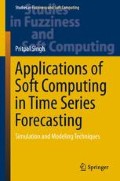Abstract
As the application of information technology is growing very rapidly, data in various formats have also proliferated over the time.
The best way to predict your future is to create it.
Peter F. Drucker
Access this chapter
Tax calculation will be finalised at checkout
Purchases are for personal use only
Notes
- 1.
- 2.
- 3.
- 4.
- 5.
- 6.
- 7.
References
Chen SM (1996) Forecasting enrollments based on fuzzy time series. Fuzzy Sets Syst 81:311–319
Cheng C, Chang J, Yeh C (2006) Entropy-based and trapezoid fuzzification-based fuzzy time series approaches for forecasting IT project cost. Technol Forecast Social Change 73:524–542
Egrioglu E, Aladag CH, Yolcu U, Uslu V, Erilli N (2011) Fuzzy time series forecasting method based on Gustafson-Kessel fuzzy clustering. Expert Syst Appl 38(8):10355–10357
Gadgil S, Srinivasan J, Nanjundiah RS, Kumar KK, Munot AA, Kumar KR (2002) On forecasting the Indian summer monsoon: the intriguing season of 2002. Curr Sci 83(4):394–403
Gadgil S, Rajeevan M, Nanjundiah R (2005) Monsoon prediction-why yet another failure? Curr Sci 88(9):1389–1400
Gooijer JGD, Hyndman RJ (2006) 25 years of time series forecasting. Int J Forecast 22(3):443–473
Huang YL, Horng SJ, He M, Fan P, Kao TW, Khan MK, Lai JL, Kuo IH (2011) A hybrid forecasting model for enrollments based on aggregated fuzzy time series and particle swarm optimization. Expert Syst Appl 38(7):8014–8023
Huarng K (2001a) Effective lengths of intervals to improve forecasting in fuzzy time series. Fuzzy Sets Syst 123:387–394
Huarng K (2001b) Heuristic models of fuzzy time series for forecasting. Fuzzy Sets Syst 123:369–386
Huarng K, Yu THK (2006) Ratio-based lengths of intervals to improve fuzzy time series forecasting. IEEE Trans Syst Man Cybern Part B Cybern 36(2):328–340
Huarng KH, Yu THK, Hsu YW (2007) A multivariate heuristic model for fuzzy time-series forecasting. IEEE Trans Syst Man Cybern Part B: Cybern 37:836–846
Hwang JR, Chen SM, Lee CH (1998) Handling forecasting problems using fuzzy time series. Fuzzy Sets Syst 100:217–228
Kuo IH, Horng SJ, Kao TW, Lin TL, Lee CL, Pan Y (2009) An improved method for forecasting enrollments based on fuzzy time series and particle swarm optimization. Expert Syst Appl 36(3, Part 2):6108–6117
Kuo IH, Horng SJ, Chen YH, Run RS, Kao TW, Chen RJ, Lai JL, Lin TL (2010) Forecasting TAIFEX based on fuzzy time series and particle swarm optimization. Expert Syst Appl 37(2):1494–1502
Li ST, Chen YP (2004) Natural partitioning-based forecasting model for fuzzy time-series. IEEE Int Conf Fuzzy Syst 3:1355–1359
Mahnam M, Ghomi SMTF (2012) A particle swarm optimization algorithm for forecasting based on time variant fuzzy time series. Int J Ind Eng Prod Res 23(4):269–276
Park J, Lee DJ, Song CK, Chun MG (2010) TAIFEX and KOSPI 200 forecasting based on two-factors high-order fuzzy time series and particle swarm optimization. Expert Syst Appl 37(2):959–967
Preethi B, Revadekar JV, Kripalani RH (2011) Anomalous behaviour of the indian summer monsoon 2009. J Earth Syst Sci 120(5):783–794
Sheikhan M, Mohammadi N (2012) Time series prediction using PSO-optimized neural network and hybrid feature selection algorithm for IEEE load data. Neural Comput Appl
Singh P, Borah B (2012) An effective neural network and fuzzy time series-based hybridized model to handle forecasting problems of two factors. Knowl Inf Syst 38(3):669–690
Singh P, Borah B (2013a) An efficient time series forecasting model based on fuzzy time series. Eng Appl Artif Intell 26:2443–2457
Singh P, Borah B (2013b) Forecasting stock index price based on M-factors fuzzy time series and particle swarm optimization. Int J Approx Reason
Singh P, Borah B (2013c) High-order fuzzy-neuro expert system for daily temperature forecasting. Knowl-Based Syst 46:12–21
Singh P, Borah B (2013d) Indian summer monsoon rainfall prediction using artificial neural network. Stoch Environ Res Risk Assess 27(7):1585–1599
Song Q, Chissom BS (1993a) Forecasting enrollments with fuzzy time series—Part I. Fuzzy Sets Syst 54(1):1–9
Song Q, Chissom BS (1993b) Fuzzy time series and its models. Fuzzy Sets Syst 54(1):1–9
Song Q, Chissom BS (1994) Forecasting enrollments with fuzzy time series - Part II. Fuzzy Sets Syst 62(1):1–8
Swaminathan MS (1998) Padma Bhusan Prof. P. Koteswaram First memorial lecture-23rd March 1998. In: Climate and sustainable food security, vol 28, Vayu Mandal, pp 3–10
Yu HK (2005) Weighted fuzzy time series models for TAIEX forecasting. Phys A: Stat Mech Appl 349(3–4):609–624
Author information
Authors and Affiliations
Corresponding author
Rights and permissions
Copyright information
© 2016 Springer International Publishing Switzerland
About this chapter
Cite this chapter
Singh, P. (2016). Introduction. In: Applications of Soft Computing in Time Series Forecasting. Studies in Fuzziness and Soft Computing, vol 330. Springer, Cham. https://doi.org/10.1007/978-3-319-26293-2_1
Download citation
DOI: https://doi.org/10.1007/978-3-319-26293-2_1
Published:
Publisher Name: Springer, Cham
Print ISBN: 978-3-319-26292-5
Online ISBN: 978-3-319-26293-2
eBook Packages: EngineeringEngineering (R0)

